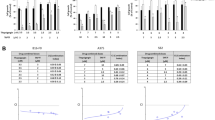Abstract
Prostaglandin D2 (PGD2) is lethal to murine and human melanoma cells at high doses, but synchronizes cells at G1 at non-toxic doses (2.5 or 5 μg/ml). We tested the lethality to B16 mouse melanoma cells of combinations of PGD2 with anticancer drugs. The drugs selected were mostly those used in treating human melanoma: actinomycin D, Bleomycin, BCNU, cis-platin, melphalan, 5-fluorouracil, and 1-β-D-arabinofuranosylcytosine (ara-C). PGD2 was combined with the drugs according to 3 different protocols:
Protocol 1
An asynchronous culture was given a long term (24 hr) exposure simultaneously to PGD2 + drug. Combinations with Bleomycin, ara-C or melphalan were additive or slightly antagonistic whereas PGD2 plus actinomycin D was significantly antagonistic.
Protocol 2
Cells synchronized in G1 by 24 hr PGD2 exposure were then given a short-term (2 hr) treatment with PGD2 + drug. Combinations with cis-platin, Bleomycin, BCNU or 5-fluorouracil were additive or slightly antagonistic, whereas melphalan and actinomycin D combinations were significantly antagonistic.
Protocol 3
Cells were released from a PGD2-induced G1 block and were exposed to drug at different times during cell progression. Actinomycin D was antagonistic when added immediately after release from the G1 block, but was significantly synergistic when added 10 to 12 hr later.
The effect of the combinations cannot be explained by available cell cycle or biochemical information. The antagonism between PGD2 and several of the drugs resembles the “cytoprotective” effect of PGD2 towards various noxious agents.
Similar content being viewed by others
References
Santoro MG, Philpott GW, Jaffe BM: Inhibition of B16 melanoma growth in vivo by a synthetic analog of prostaglandin E2 Cancer Res 37:3774–3779, 1977
Bregman MD, Sander D, Meyskens Jr FL: Prostaglandins A1 and E1 inhibit the plating efficiency and proliferation of murine melanoma cells (Cloudman S-91) in soft agar. Biochem Biophys Res Commun 104:1080–1086, 1982
Honn KV, Romine M, Skoff A: Prostaglandin analogs as inhibitors of tumor cell DNA synthesis. Proc Soc Exp Biol Med 166:562–567, 1981
Bregman MD, Meyskens Jr FL: Inhibition of human malignant melanoma colony-forming cells in vitro by prostaglandin A1. Cancer Res 43:1642–1645, 1983
VonHoff DD, Clark GM, Stogdill BJ, Sarosdy MF, O'Brien MT, Casper JT, Mattox DE, Page CP, Cruz AB, Sandbach JF: Prospective clinical trial of a human tumor cloning system. Cancer Res 43:1926–1931, 1983
Bhuyan BK, Adams EG, Li LH, Timmins L, Badiner GJ, Barden K: Cytotoxicity and cell cycle effects of prostaglandins (PGs) on human and murine melanoma cells. Cancer Res 46:1688–1693, 1986
Wiley HM, Feingold KR, Wu J: Control of lymphoma cell growth by prostaglandins. (Abstract) Clinical Res 31:69A, 1983
Hughes-Fulford M, Wu J, Fukushima M: Control of cell cycle by PGJ2: a potential new class of anti-neoplastic agents. In: Bailey JM (ed) Symposium on prostaglandins and leukotrienes, Washington, 1984, pp. 128
Fukushima M, Kato T, Ueda R, Ota K, Narumiya S, Hayaishi O: Prostaglandin D2, a potential antineoplastic agent. Biochem Biophys Res Commun 105:956–964, 1982
Sakai T, Yamaguchi N, Kawai K, Nishino H, Iwashima A: Prostaglandin D1 inhibits the proliferation of human malignant tumor cells. Prostaglandins 27:17–26, 1984
Fukushima M, Kato T, Ota K: In vivo activity of the antineoplastic prostaglandin. (Abstract) Proc Amer Assoc Cancer Res 25:350, 1984
Fitzpatrick FA, Stringfellow DA: Prostaglandin formation by malignant melanoma cells correlates inversely with cellular metastasis potential. Proc Natl Acad Sci(USA) 76:1765–1769, 1979
Bhuyan BK, Blowers CL, Crampton SL, Shugars KD: Cell-kill kinetics of several nogalamycin analogs and Adriamycin for Chinese hamster ovary, L1210 leukemia and B16 melanoma cells in culture. Cancer Res 41:18–24, 1981
Valeriotte F, Lin H: Synergistic interaction of anticancer agents. A cellular perspective. Cancer Treat Rep 59:895–899, 1975
Adams EG, Crampton SL, Bhuyan BK: Effect of 7-con-O-methylnogarol on DNA synthesis, survival and cell cycle progression of Chinese hamster ovary cells. Cancer Res 41:4981–4987, 1981
Bhuyan BK, Scheidt LG, Fraser TJ: Cell cycle phase specificity of antitumor agents. Cancer Res 32:398–407, 1972.
Madoc-Jones H, Mauro F: Site of action of cytotoxic agents in the cell life cycle. In: Sartorelli AC, Johns DG (eds) Antineoplastic and immunosuppressive agents. Vol. 1, Springer-Verlag, Heidelberg, 1974, pp. 205–219
Loewe S: The problem of synergism and antagonism of combined drugs. Arzneimittelforsch 3:285–320, 1953
Chou T-C, Talalay P: Quantitative analysis of dose-effect relationships: The combined effects of multiple drugs or enzyme inhibitors. Adv Enzyme Regulation 22:27, 1984
Bregman MD, Peters E, Sander D, Meyskens FL: Dexamethasone, prostaglandin A1 and retinoic acid modulation of murine and human melanoma cells grown in soft agar. J Natl Cancer Inst 71:927–932, 1983
Kushima M, Kato T, Ota K, Kikuchi H, Yamada Y, Kitagawa I: Antitumor activities of marine prostanoids, Clavulone (Claviridenone) — comparison with antineoplastic prostaglandins. (Abstract) Proc Jap Cancer Assoc 42:243, 1983
Wiley MH, Feingold KR, Grunfeld C, Quesney-Haneeus V, Wu JM: Evidence for c-AMP-independent inhibition of S-phase DNA synthesis by prostaglandins. J Biol Chem 258:491–496, 1983
Robert A, Nezamis JE, Lancaster C, Hanchar AJ: Cytoprotection by prostaglandins in rats. Prevention of gastric necrosis produced by alcohol, HCl, NaOH, Hypertonic NaCl and thermal injury. Gastroenterology 77:433–443, 1979
Raskin DJ, Gray K: Cytoprotection of the urinary bladder with 16, 16-dimethyl prostaglandin E2 during cyclophosphamide therapy. (Abstract) Proc Amer Assoc Cancer Res 25:351, 1984
Author information
Authors and Affiliations
Rights and permissions
About this article
Cite this article
Bhuyan, B.K., Badiner, G.J., Adams, E.G. et al. Cytotoxicity of combinations of prostaglandin D2 (PGD2) and antitumor drugs for B16 melanoma cells in culture. Invest New Drugs 4, 315–323 (1986). https://doi.org/10.1007/BF00173504
Issue Date:
DOI: https://doi.org/10.1007/BF00173504




